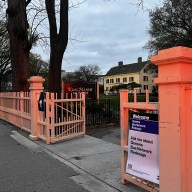By Dustin Brown
The future of the contaminated Phelps Dodge site in Maspeth has been closely watched for years by community leaders intent on seeing the removal of waste left behind by decades of industrial pollution.
But a member of Community Board 5 denounced the state Department of Environmental Conservation last week for excluding the public as it decides how best to clean the property.
The DEC held a public meeting Aug. 28 at Queens Borough Hall to explain six alternatives to clean up the 35-acre site owned by the Phelps Dodge mining company, which is managing and funding the project. The property, which sits between 56th Road and the Newtown Creek directly east of the Kosciuszko Bridge, was placed on the state’s registry of inactive hazardous waste disposal sites in 1980.
But only about four people from the community actually attended the hearing.
“There wasn’t a big turnout,” said Peter Constantakes, a spokesman for the DEC, in a phone interview last Thursday. “It’s unfortunate that people were apparently unaware of it. We’ll look into seeing if it would be appropriate to hold another.”
Tony Nunziato, the chairman of the environmental services committee for Community Board 5, brought the hearing’s sparse attendance to the board’s attention at its monthly meeting Sept. 18, where he blasted the DEC for failing to give adequate notice to the community. He claimed public officials were not informed of the hearing and criticized the DEC for holding the event only days before Labor Day, when many New Yorkers are out of town.
“I believe the public has a right to input,” said Nunziato, who attended the hearing himself. “There was no public input there.”
Constantakes responded that notice of the hearing had been sent to a long list of area officials, while the monthlong public comment period that began Aug. 14 was extended one week, ending Sunday.
The community board passed a unanimous resolution urging the state DEC “to extend the narrow time period for public comment” until another “well advertised” meeting could be scheduled.
But the DEC was not planning to extend the comment period any further, Constantakes said Tuesday.
Nunziato said he was not protesting the content of the clean-up proposals themselves, only the state’s failure to involve the public.
“It could be the best thing, what they’re suggesting, it could be the worst thing,” he said. “I believe when you have something run by the state, by the people for the people, you’ve got to have the people there.”
Testing of the site revealed the soil is contaminated with PCBs and metals, while inorganic metals and volatile organic compounds were found in the groundwater .
Out of the six alternatives outlined in the state’s Proposed Remedial Action Plan, or PRAP, the DEC has recommended the fifth clean-up option, which ranks second highest in both thoroughness and expense.
The proposal, which would cost about $12 million to carry out, calls for the hot spot removal of contaminated soils, the placement of a cap over the entire property, the extraction of groundwater, the creation of a containment and treatment system and long-term groundwater monitoring.
The sixth alternative would involve the removal of about 536,000 cubic yards of soil and would cost about 10 times more than the preferred proposal, between $104 and $229 million.
“No matter what is done, it will be fully protective of public health and the environment,” Constantakes said.
Nunziato said he is also concerned that the plan has no provisions for cleaning Newtown Creek.
“I just want to make sure the cleanup of the creek is in place before any transactions are taking place with the property,” he said.
Constantakes said more research into the contamination of the creek must be performed before it is cleaned, which will be undertaken in a later phase of the project.
A copper smelting plant began operating as early as 1888 on the site, which Phelps Dodge purchased in the late 1920s and used for manufacturing until 1983, when it began removing equipment and clearing out the buildings. Although the U.S. Postal Service bought the site in 1986, Phelps Dodge was forced by lawsuit to reacquire the site in 1997 because of its contamination.
A local company recently signed an agreement to purchase the site, Phelps Dodge spokesman Bruce Richardson said.
Reach reporter Dustin Brown by e-mail at Timesledger@aol.com or call 229-0300, Ext. 154.































